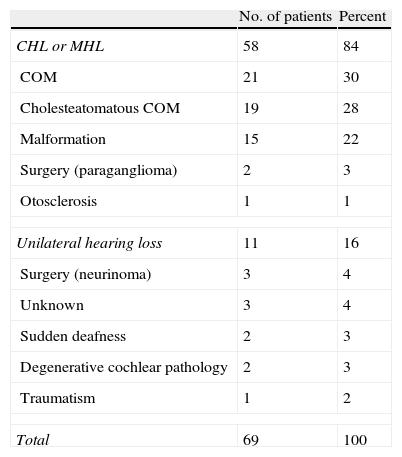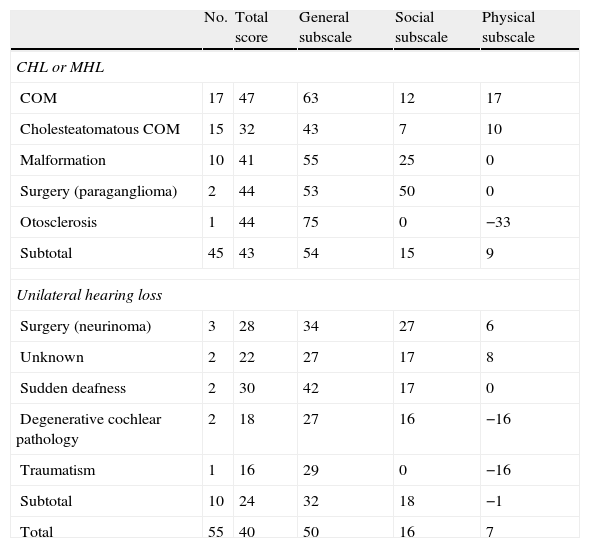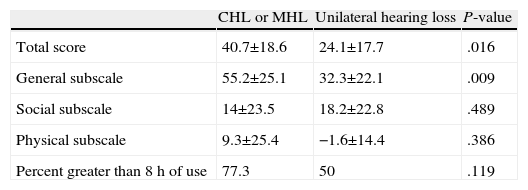To assess the improvement of quality of life in osseointegrated implanted patients, taking into account the indication as well as the use of the implant, and the presence of pre- and postoperative tinnitus.
MethodsSixty-nine patients implanted between June 2004 and November 2010 were included. The average age of the patients was 40 years. The instruments used to quantify the change in quality of life were the Glasgow Benefit Inventory and a questionnaire including open questions, bone anchored hearing aid (BAHA) use, change in tinnitus and postoperative pain.
ResultsThe average total benefit score with the Glasgow Benefit Inventory was 38, and the general, social, and physical scores were 51, 15 and 7, respectively. There was no significant association between sex, age and bilaterality or unilaterality of the process with quality of life. Nevertheless, there were significantly better results in patients with conductive hearing loss than in those with unilateral deafness, and the results were positive although in both groups. The tinnitus rate went from 37.5 to 20.8% following BAHA, with this difference being significant.
ConclusionsOur results show that the use of BAHA is associated with a great improvement in quality of life for patients with conductive hearing loss, whereas indications in unilateral deafness have to be individually studied. Moreover, the study shows that BAHA has a positive effect upon tinnitus.
Cuantificar la mejoría en la calidad de vida en los pacientes osteoimplantados, teniendo en consideración tanto la indicación del implante como su uso y la presencia de acúfenos.
MétodosEste estudio incluye a 69 pacientes implantados entre junio de 2004 y noviembre de 2010. La edad media de los pacientes fue de 40 años. El instrumento empleado para la medición de la calidad de vida fue el Glasgow Benefit Inventory (GBI) y un cuestionario con preguntas abiertas, uso del BAHA, modificación del acúfeno y presencia o no de dolor.
ResultadosLa puntuación media del GBI total fue de 38, y en las subescalas general, social y física: 51, 15 y 7 respectivamente. La media de horas al día de utilización fue de 11. No se encontró relación significativa entre el sexo, edad y bilateralidad o unilateralidad del proceso con la calidad de vida. En cambio se observaron diferencias significativas entre los pacientes con hipoacusia transmisiva y con cofosis unilateral, si bien en ambos grupos los resultados fueron positivos. La presencia de acúfeno disminuyó de un 37,5 a un 20,8%, siendo esta diferencia estadísticamente significativa.
ConclusionesNuestros resultados muestran que el uso del BAHA se asocia a una clara mejoría en la calidad de vida de los pacientes, menor en cofosis unilaterales, siendo necesario individualizar su indicación en este grupo. Asimismo muestran que el uso del BAHA tiene un efecto beneficioso sobre el acúfeno.
Artículo
Comprando el artículo el PDF del mismo podrá ser descargado
Precio 19,34 €
Comprar ahora









